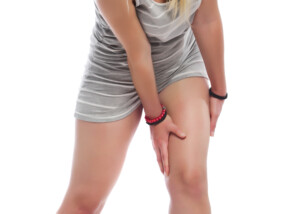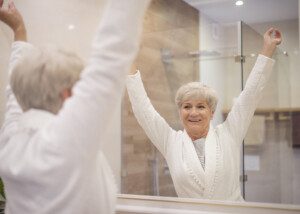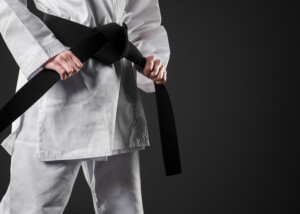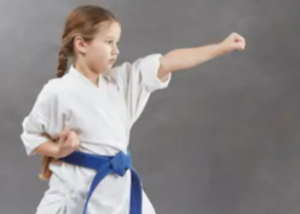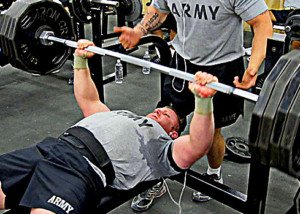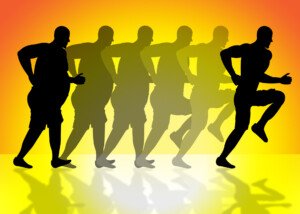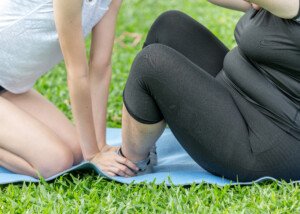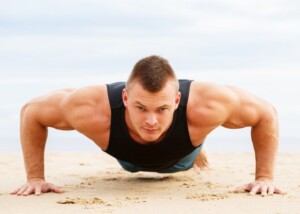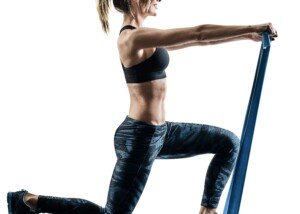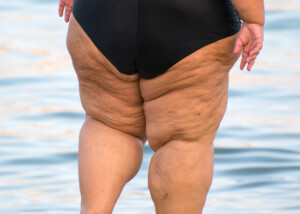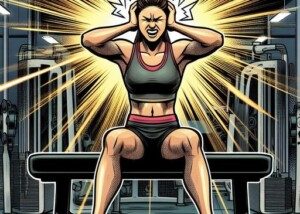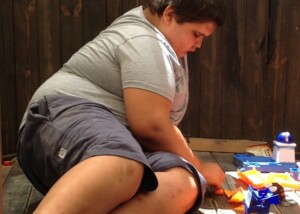Are You a Runner with a Hamstring Injury? Treatment Option
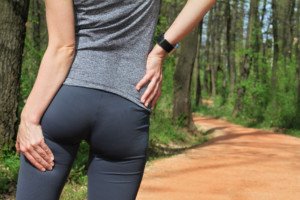
If you haven’t injured a hamstring from running, it’s only a matter of time, so at least get ahead of the game and know how to prevent these and how to treat this injury should you fall victim to it.
I injured my hamstring from running; my hamstring injury is healed. So here is my article on treatment options for hamstring injuries as they apply to runners. (more…)
Minimum Steps You Should Take Every Day for Health Benefits

Perhaps you’ve seen a lot of articles pushing for 10,000 steps a day to gain health and fitness benefits, but is this the minimum requirement?
What if you can’t figure out a way to accumulate 10,000 steps every single day?
A study of this determined that the daily step total should be lowered to 6,000.
The report is in the November 2012 Menopause, and states that at least 6,000 steps a day will contribute to better health, though the study focused on middle-aged and older women rather than the general population.
Life as a couch potato is harmful to the body, and the more that you move in daily life, the healthier and fitter you’ll be.
If you’re sedentary and want to be healthier, start by wearing a pedometer to attain 6,000 steps a day.
Though relying ONLY on step totals is not the best approach to health and fitness, it IS a great way to get launched towards a fitter and healthier lifestyle.
The 6,000 steps a day is also highly applicable to those folks who are indeed committed to ongoing strenuous exercise — but for the remainder of the day are very sedentary, spending hours and hours at the computer or watching TV.
These individuals should tally daily step totals with a pedometer outside of their structured exercise sessions.
The Study
It involved 292 women (45 to 72) who wore pedometers.
The cutoff point for daily step totals was 6,000: Women who took fewer than 6,000 steps a day were deemed inactive.
All the women had health checks that included blood sugar, waist/hip measurement and cholesterol profile.
The women whose pedometers recorded over 6,000 steps a day were far less likely to be obese or have diabetes or metabolic syndrome, when compared to the inactive women.
Whether or not they’d gone through menopause or had hormone therapy did not influence results.
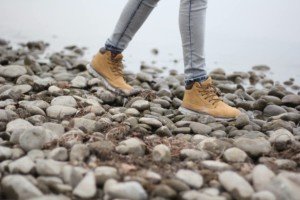
Tips on Accumulating 6,000 Steps Per Day
I have a treadmill desk and know firsthand how valuable this tool is for accumulating steps throughout the day.
For instance, when it’s time to peruse news sites for the latest stories, you can do this while walking slowly on the treadmill desk.
You can also pace about the house during TV commercials if you watch shows in real time.
If you strength train at a gym, walk around between sets instead of sitting on the equipment.
If you think someone might take the equipment while you’re walking away from it, then confine your steps to close-by.
 Lorra Garrick has been covering medical, fitness and cybersecurity topics for many years, having written thousands of articles for print magazines and websites, including as a ghostwriter. She’s also a former ACE-certified personal trainer.
Lorra Garrick has been covering medical, fitness and cybersecurity topics for many years, having written thousands of articles for print magazines and websites, including as a ghostwriter. She’s also a former ACE-certified personal trainer.
.
Source: sciencedaily.com/releases/2012/11/121121130821.htm
Best Kinds of Exercise for Depression and Weight Loss

Exercise fights depression and weight loss, and one study after another confirms the strong tie between exercise and alleviation of depression symptoms.
A Southern Methodist University study shows that exercise is a potent treatment for depression and anxiety.
Before you start a workout program, the study authors recommend a health assessment to clear the patient for physical activity.
The general recommendations for exercise apply to depressed but apparently healthy people.
This means 150 minutes weekly of moderate-intensity exercise, or, 75 minutes of vigorous exertion.
But which will work better for depression, and weight loss: 150 minutes of moderate-intensity, or 75 minutes of rigorous exercise a week?
Go for the 75 minutes, hands down. Intense exercise causes hormonal changes in the body that trigger weight loss in the form of fat lost, while keeping valuable muscle tissue intact.
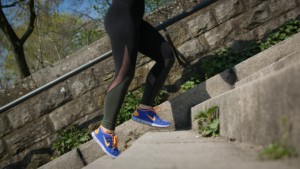
Moderate level workouts fail to do this. Intense exercise that elicits the best hormonal response is the kind called high intensity interval training, as well as a kind of exercise called burst training.
A 2002 issue of the Journal of Applied Physiology reports that high intensity training, involving sprints, produced 96 percent more human growth hormone when compared to slower long duration jogging.
Growth hormone release creates breakdown of fat, which means weight loss.
Other benefits include increased energy, increased libido and improved sleep, and these improvements will go a long way in alleviating symptoms of depression.
People with depression, including depression caused by weight loss struggles, can begin by walking…the anaerobic way, for maximum weight loss. However, include strength training in your regimen. Don’t just do cardio.
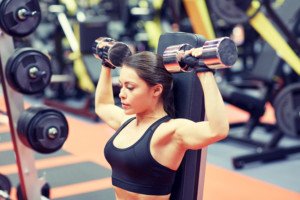
Shutterstock/Syda Productions
Strength training, like cardio (walking, running, cycling) can be done intensely. Intense exercise helps alleviate depression simply because it creates a feeling of accomplishment.
You’ll be much more amazed at yourself after doing high intensity interval training as opposed to mere, boring long duration cardio like prolonged boring pedaling on an elliptical machine or endless laps walking around the block.
Another type of exercise that will fight depression and encourage weight loss is the martial arts.
Martial arts, by their nature, involve bouts of intense training, or burst-style training.
Plus, the sense of accomplishment will be unlike anything you’ve ever experienced; I’ve trained in the martial arts for years, and it just feels so great developing skills in this discipline.
And weight loss will be a sure result, and this of course will help relieve your depression, as you become fitter.
 Lorra Garrick has been covering medical, fitness and cybersecurity topics for many years, having written thousands of articles for print magazines and websites, including as a ghostwriter. She’s also a former ACE-certified personal trainer.
Lorra Garrick has been covering medical, fitness and cybersecurity topics for many years, having written thousands of articles for print magazines and websites, including as a ghostwriter. She’s also a former ACE-certified personal trainer.
.
Source: Southern Methodist University (2010, April 6). Mental health providers should prescribe exercise more often for depression, anxiety, research suggests. ScienceDaily. Retrieved January 6, 2011, from http://www.sciencedaily.com¬ /releases/2010/04/100405122311.htm
Top 3 Exercises to Prevent Osteoporosis in Women Over 50
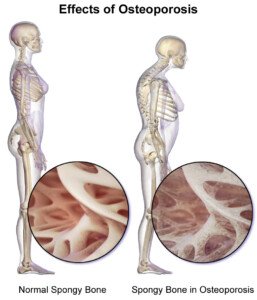
Women who are over 50 and postmenopausal can scare off osteoporosis with just these three exercises.
For women over 50, especially postmenopausal, osteoporosis looms, but you can keep this disease far away from you with just three exercises.
Even if you’re new to strength training, and even if you feel “totally out of shape,” you can make these three exercises do wonders for your bone density.
The top three exercises for preventing osteoporosis in women 50 and older:
#1. Deadlift
#2. Squat
#3. Bench Press
These exercises are “top 3” material when it comes to so many things, including prevention of osteoporosis, and including causing dramatic improvements in the health and fitness of women age 50 and over.
A report from the International Osteoporosis Foundation warns that postmenopausal women need to take the threat of this disease very seriously.
Osteoporosis is what turns a once erect, healthy looking woman into a “little old lady” who’s lost a lot of her height.
The IOF report notes that postmenopausal women are at most risk for the fallout of osteoporosis which includes bone fractures.
One-third of all women over 50, says the IOF report, will suffer a fractured bone due to this disease.
Deadlift, Squat, Bench Press
Even if a woman is postmenopausal, it’s NEVER too late for strength training to strengthen the bones.
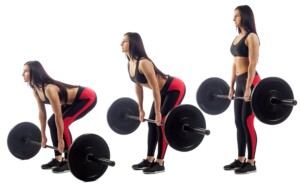
Deadlift. Shutterstock/Everyonephoto Studio
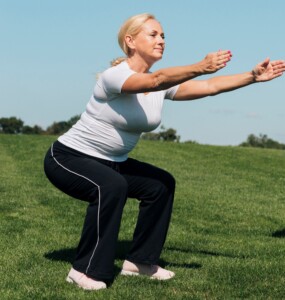
Squat. Freepik.com
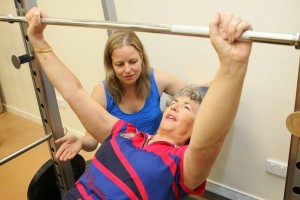
Bench press
Shocking
The report also says that bone fractures result in more time spent in a hospital than does breast cancer, for women over 45.
How can the top three exercises for 50-plus women strengthen bone and help prevent osteoporosis?
They force contractions of multiple, large muscle groups.
When a muscle contracts, it pulls on the bone to which it is attached (it’s attached via a tendon). This pulling on the bone forces the bone to increase in density.
 Lorra Garrick is a former personal trainer certified through the American Council on Exercise. At Bally Total Fitness she trained women and men of all ages for fat loss, muscle building, fitness and improved health.
Lorra Garrick is a former personal trainer certified through the American Council on Exercise. At Bally Total Fitness she trained women and men of all ages for fat loss, muscle building, fitness and improved health.
.
Top image: BruceBlaus/CreativeCommons
Source: sciencedaily.com/releases/2013/10/131010091653.htm
Best Strength Training Exercises for People over 90

Even if you’re 90 years old, even in the mid-90s, it’s not too late to gain amazing benefits from strength training, even if you’ve never picked up a piece of metal in your entire life. (more…)
Can Weak Core Strength Shorten Your Lifespan?
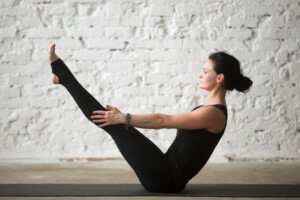
A study shows that the fewer sit-ups one can do, the higher the all-cause mortality risk; here’s how to get a strong core which will then help lengthen your lifespan. (more…)
Should Young Adults Have Weight Loss Surgery?
Should a young adult undergo weight loss surgery or should he or she keep working at diet and exercise to lose the weight naturally? (more…)
Mild Traumatic Brain Injury vs. Concussion: What’s the Difference?
Is it just a matter of word choice when it comes to a concussion vs. a mild traumatic brain injury?
Or are these two distinct conditions with medical differences?
According to a report in Neurosurgery, the Concussion in Support Group (CISG 4) advises that “no athlete at any age or level of competition” should return to their game or practice on the same day that the condition is diagnosed.”
In general, when someone is diagnosed with a concussion, there is a rapid onset of neurological symptoms that are short-lived, resolving spontaneously. In fact, about 80-90 percent of cases resolve in seven to 10 days.
Is there a medical difference between a concussion and a mild traumatic brain injury?
“Concussion usually refers to sports related head injuries and is a type of mild TBI,” says D’Wan Carpenter, DO, a board certified physical medicine and rehabilitation physician with SIMEDHealth in FLA.
“They are identified by the time, if any, loss of consciousness, post-traumatic amnesia and confusion.
“For all mild TBI (including concussion) loss of consciousness is less than 30 minutes, post-traumatic amnesia less than 24 hours, and Glascow coma scale (GCS) 13-15.”
Is imaging different between people diagnosed with a concussion vs. a mild TBI?
Dr. Carpenter explains, “For both concussion and mild TBI, imaging is typically normal.
“If there are imaging abnormalities to categorize a mild TBI, it is then classified as a complicated mild TBI.
“In short, I would disagree with the school of thought which distinguishes concussion and mild TBI simply based on imaging.”
Outward Appearance of Patient with Head Trauma
When my father fell and struck his head, he displayed neurological symptoms: initial belligerence (not characteristic of him), not thinking clearly, perseveration (repeating the same words/phrase over and over), short-term memory loss and the inability to recall that a few weeks prior, he’d undergone knee replacement surgery.
However, the CT scans of his brain upon ER admission, and the day after, were normal.
The symptoms resolved over the next several hours after ER admission, and there were never any other issues.
When my mother fell and struck her head, she displayed NO neurological symptoms at all. And her CT scan that day and the next were normal.
However, six weeks later she developed neurological symptoms. The CT scan showed bleeding in her brain: a chronic subdural hematoma. At that point she was diagnosed with a mild traumatic brain injury.
Don’t Get Caught up with Terminology
• Instead pay close attention to symptoms, especially if they worsen.
• For athletes who take a good hit to the head, a rest period of 24-48 hours is very important, followed by a gradual return to sport — with medical clearance.
• A headache that’s worsening is a very concerning symptom, especially if accompanied by nausea/vomiting, increasing drowsiness or altered mental status.
• The absence of a bleeding gash or “bump” on the head is not predictive of a mild brain injury vs. more severe.
 Dr. Carpenter is one of the nation’s top board-certified physical medicine and rehabilitation physicians, a national speaker, medical legal expert and independent medical examiner. She is founder and Chief Medical Officer of DJC Physical Medicine Consultants. Follow Dr. D’Wan on Twitter.
Dr. Carpenter is one of the nation’s top board-certified physical medicine and rehabilitation physicians, a national speaker, medical legal expert and independent medical examiner. She is founder and Chief Medical Officer of DJC Physical Medicine Consultants. Follow Dr. D’Wan on Twitter.
 Lorra Garrick is a former personal trainer certified through the American Council on Exercise. At Bally Total Fitness she trained women and men of all ages for fat loss, muscle building, fitness and improved health.
Lorra Garrick is a former personal trainer certified through the American Council on Exercise. At Bally Total Fitness she trained women and men of all ages for fat loss, muscle building, fitness and improved health.
Top image: ©Lorra Garrick
Source: sciencedaily.com/releases/2013/12/131205102154.htm
How Plus Size Women Can Gain Self-Confidence at a Gym

The gym is not a place for feeling self-conscious and even embarrassed of your body, but that seems to be exactly what many overweight women use it for.
Some of women get so distracted by it that they spend more time worried about who’s looking at them than in actually getting the work done that they came there to do.
This may be hard to hear, but such thinking at the gym is just totally uncalled for.
The main reason it’s so detrimental is that if overweight women weren’t focused on what people think about their body, then they’d be much further along in their progress.
Making or bringing friends can help overweight women feel less self-conscious at the gym setting.
It’s great to have a workout buddy. Not only can they uplift and encourage, but they can serve as a distraction that keeps the mind off what other people around might be thinking — or shall I say, what the self-conscious woman only thinks they might be thinking.
Who cares what they think anyway? That’s none of your business now, is it?
Enjoying the company of someone you’re compatible with can block all the negative thinkers out of your mind, if there are any.
If you can’t make friends at the gym, then convince some of your other friends to come along.
Be proud of accomplishments instead of feeling self-conscious.
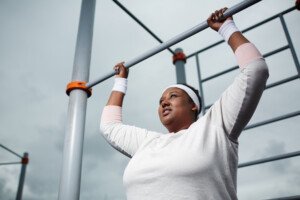
Shutterstock/Pressmaster
What’s behind the feelings of self-consciousness some overweight women experience while at the gym?
It represents their belief that there’s something wrong with the way they look.
It’s really a projection of their own dissatisfaction with their weight.
It would be so much better to celebrate your small accomplishments and feel good about every pound and inch lost.
Focus on how much weight you’re pushing, pulling or hoisting.
Think about how much stronger you’re making your bones and heart.
Overweight women need to remember why they are at a gym.
You’re there to do your body good, not to win a popularity contest or try out for a modeling show.
Keeping a clear focus can stop you from feeling self-conscious.
 Lorra Garrick is a former personal trainer certified through the American Council on Exercise. At Bally Total Fitness she trained women and men of all ages for fat loss, muscle building, fitness and improved health.
Lorra Garrick is a former personal trainer certified through the American Council on Exercise. At Bally Total Fitness she trained women and men of all ages for fat loss, muscle building, fitness and improved health.
.
Top image: Freepik.com/katemangostar
Blame Diet & Exercise Habits on Childhood Obesity, Not Genes
Childhood obesity is overwhelmingly the result of bad diet and lack of exercise, rather than genetics or heredity.
“The CDC estimates that 18.5% of U.S. children are obese, and approximately one of every three children is overweight,” says Julie Cunningham, MPH, RD, LDN, registered dietitian and certified diabetes educator.
“The rate of childhood obesity in our country began rising in the 1970’s, which is coincidentally the same decade when fast food became widely available and when soft drink consumption increased considerably.
“Fifty years is less than one lifetime, too short of a time span for our DNA to have changed, so we can’t blame heredity for our collective obesity problem.
“Our increased consumption of grains and added sugars, combined with our lack of physical activity is the reason for overweight in both children and adults.
“We have built cities that require us to use cars instead of biking or walking, and we have chosen to eat food prepared for convenience rather than nutrition.
“My son’s elementary school had ‘walk to school’ day. The school encouraged everyone to drive to a parking lot and then walk to school from there!”
A Study Shows the Obvious
An investigation by the University of Michigan Cardiovascular Center of 1,003 sixth-graders revealed that obese kids were more likely to eat a school lunch rather than a home-prepared meal, and watch TV or play videogames two hours daily.
“For the extremely overweight child, genetic screening may be a consideration,” remarks lead study author and cardiologist Kim A. Eagle, MD, in the paper.
She adds, “For the rest, increasing physical activity, reducing recreational screen time and improving nutritional value of school lunches offers great promise to begin a reversal of current childhood obesity trends.”

Shutterstock/Natee K Jindakum
For those who believe that childhood obesity is primarily fueled by genetics, ask yourself why childhood obesity rates have soared over such a short period of time.
The obesity prevalence in American youth age six to 11 was 6.5 percent in 1980, yet a whopping 19.6 percent in 2008.
Genetics do not explain this. The explosion of computer use, however, does, along with more and more junk food TV commercials and restaurants popping up everywhere.
Look at what children did in their spare time during daylight hours 50 years ago, compared to today.
They sit before computers mindlessly eating, whereas 50 years ago they ran about outdoors or did a lot of walking collecting stones, leaves or exploring the neighborhood.
The U-M researchers showed that 58 percent of fat kids had spent two hours watching TV the previous day.
The figure for health-weight kids was 41 percent. This difference is statistically very significant.
The study showed that far fewer obese children regularly exercised, participated in gym classes or played sports.
You might argue that obesity impedes sports participation, rather than lack of sports participation causes obesity.
However, obese kids have youth on their side and can fully participate in athletics.
Though they won’t be the fastest runners or quickest movers, they still have functioning muscles and bones, and can be quite active in the field or on the court.
The diet and exercise habits of the heavy kids in this study were markedly different than those of the normal-weight children, and thus, the conclusion was that lifestyle is much more tied to obesity than are genes.
“If diets and physical activity were similar in obese and non-obese students, this would argue for a stronger genetic basis for obesity in children,” says the study paper.
The study also revealed that virtually all the participants, regardless of size, reported unhealthy habits.
Though thin kids have been known to have unhealthy diets, their portion sizes tend to be a lot smaller than those of obese children.

